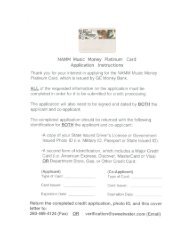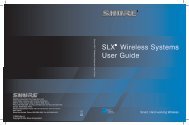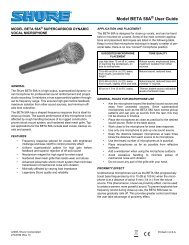Create successful ePaper yourself
Turn your PDF publications into a flip-book with our unique Google optimized e-Paper software.
Using MIDI<br />
The GW-8 can transmit and receive performance data when<br />
connected to an external MIDI device, which enables the two<br />
devices to control each other’s performance. For example, one<br />
device can play or switch sounds on the other device.<br />
MIDI stands for “Musical Instrument Digital Interface.” It is a<br />
universal standard for exchanging musical performance data<br />
among electronic musical instruments and computers.<br />
The GW-8’s MIDI connectors allow it to transmit performance<br />
data to, and receive such data from other devices. You can<br />
use the GW-8 in a wide range of ways by connecting external<br />
devices to these connectors.<br />
Connection example<br />
Before making connections with other devices, you must turn<br />
down the volume of all devices and turn off the power to avoid<br />
malfunctions or speaker damage.<br />
fig.midi.eps<br />
GW-8<br />
Play the GW-8’s sounds from your MIDI sequencer<br />
MIDI sound module/<br />
sequencer<br />
MIDI channel Track Style<br />
1 1 Accomp 1<br />
2 2 Accomp bass<br />
3 3 Accomp 2<br />
4 4 Upper Part<br />
5 5 Accomp 3<br />
6 6<br />
7 7 Accomp 4<br />
8 8 Accomp 5<br />
9 9 Accomp 6<br />
10 10 Accomp drums<br />
11 11 Lower Part<br />
12 12<br />
13 13<br />
14 14<br />
15 15 Melody Intelligence<br />
16 16<br />
MIDI Parameters<br />
For details on how to make these settings, refer to “How to<br />
Make System Settings ([MENU])” (p. 46).<br />
MIDI parameters other than “Local Switch” will be saved as<br />
soon as you exit system edit mode.<br />
MIDI Channels<br />
Use the GW-8 to play your MIDI sound module<br />
MIDI provides sixteen channels, numbered 1–16. Even if two<br />
MIDI devices are connected, you won’t be able to select or<br />
play sounds on the other device unless both devices are set to<br />
the same MIDI channel. The GW-8 is capable of receiving on<br />
all channels, 1–16.<br />
If the GW-8’s BACKING TYPE [SONG] is on, MIDI channels<br />
1–16 will be received by “Track” 1–16.<br />
If the GW-8’s BACKING TYPE [STYLE] is on, MIDI channels 1–<br />
16 will be received by the “Style” Parts.<br />
Local Switch<br />
If the notes you play on the keyboard are sent to the sound<br />
generator via both of the two routes (1) and (2) as shown in<br />
the diagram, the notes will be duplicated or interrupted. To<br />
prevent this, you can disconnect route (1) by using the “Local<br />
Off” setting.<br />
You should turn this setting Off if you’ve connected a MIDI<br />
sequencer to the GW-8.<br />
fig.local.eps<br />
(1) Local on<br />
Sound<br />
generator<br />
MIDI<br />
IN<br />
MIDI<br />
OUT<br />
Sequencer<br />
Memory<br />
MIDI<br />
OUT<br />
MIDI<br />
IN<br />
Play a note once;<br />
it‘s sounded twice<br />
(2) Thru setting turned on<br />
Immediately after the power is turned on, this setting will be<br />
On.<br />
43
















